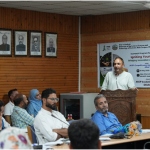The Medicinal Plants Resource Centre (MPRC) Baramulla established by Jammu and Kashmir Forest Department in North Kashmir has emerged as a learning ground for students and researchers and a nature-based tourist attraction.
The park has thousands of medicinal plants and herbs which are being grown in poly bags before being distributed to colleges, universities, and various government departments.
It is a learning ground for thousands of students and researchers studying nature in various colleges and universities of the Union Territory of Jammu and Kashmir. The park is also emerging as a major attraction for nature lovers.
The nine-acre Medicinal Plant Resource Centre, located at Khahmoh Rafiabad in the foothills of the majestic Viji Top, is revolutionising the way the forest areas are managed for the preservation of medicinal and herbal plants.
Officials in the Forest department told Rising Kashmir that the Medicinal Plants Resource Centre in north Kashmir’s Baramulla district has been set up to conserve different herbal plants which were at the verge of extinction.
The park, which is located around 20 kilometres from the district administrative centre in Baramulla, is lined with numerous deodar and other trees and has several medicinal and herbal plants.
While talking to Rising Kashmir, Mansoor Rahim, Block Forest Officer, Shalkote Forest Block of Rafiabad Range said the park established three years ago has around 50 different species of medicinal plants, herbs and flowers, with the majority of endangered species.
According to him, the major goal of the medicinal park is to preserve various plant species with medicinal and herbal properties for use by future generations.
“It was vital to establish a location where we can plant these rare species that are otherwise on the verge of extinction in Jammu and Kashmir since we have noticed a reduction in medicinal and herbal plants in our forests, ” Mansoor added.
He added that another goal of the park was to instruct visitors—including teachers, students, and researchers—about the various plants and herbs found throughout Kashmir.
“This year only, we received students from tens of local schools, colleges, universities visiting this park. Even researchers from SKUAST and Forest Training School Chiternag, Bandipora also visited the park for their research projects and seeking information about herbs and plants with rich medicinal properties,” he added.
Mansoor said there are already 50 different endangered plant species in the park, and that pupils are receiving instruction on the value of the plants and herbs that can be found in forests.
“At this park we have medicinal plants like Saussurea costus or (Kuth), Aconitum heterophyllum ( patrees), Trillium govanianum ( tripater), Inula racemosa ( poshkarmala), Dipsacus inermis (wapulhaak) and other species which are either endangered or nowhere in use,” the official said.
He claimed that the park, which features eco-friendly places for tourists and small enclosures or nests for birds and bee colonies, is also a top tourist destination in all of north Kashmir.
He said the centre established by the Forest Department under the supervision of Irfan Rasool Wani Forest Conservator north Kashmir, will draw tourists and college and university students, boosting the local economy and paving the way for the residents to live honourably.
Mansoor asserted that the Forest Department was making all required preparations to draw tourists from all across Kashmir to the park and encourage them to appreciate it for what it is “a stunning natural setting”.








